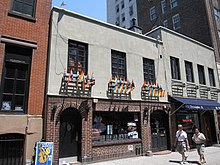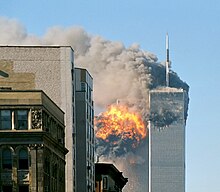New York – often called New York City or the City of New York to distinguish it from the State of New York, of which it is a part – is the most populous city in the United States and the center of the New York metropolitan area, the premier gateway for legal immigration to the United States[8][9][10] and one of the most populous urban agglomerations in the world.[11][12]
A global power city,[13] New York exerts a significant impact upon commerce, finance, media, art, fashion, research, technology, education, and entertainment. Home to the headquarters of the United Nations,[14] New York is an important center for international diplomacy[15] and has been described as the cultural and financial capital of the world.[16][17][18][19][20]
Situated on one of the world's largest natural harbors,[21] New York City consists of five boroughs, each of which is a county of New York State.[22] The five boroughs – Brooklyn, Queens, Manhattan, the Bronx, and Staten Island – were consolidated into a single city in 1898.[23] With a census-estimated 2014 population of 8,491,079[1][24] distributed over a land area of just 305 square miles (790 km2),[25] New York is the most densely populated major city in the United States.[26] As many as 800 languages are spoken in New York,[27][28] making it the most linguistically diverse city in the world.[28][29][30] By 2014 census estimates, the New York City metropolitan region remains by a significant margin the most populous in the United States, as defined by both the Metropolitan Statistical Area (20.1 million residents)[5] and the Combined Statistical Area (23.6 million residents).[6] In 2013, the MSA produced a gross metropolitan product (GMP) of nearly US$1.39 trillion,[31] while in 2012, the CSA[32] generated a GMP of over US$1.55 trillion, both ranking first nationally by a wide margin and behind the GDP of only twelve nations and eleven nations, respectively.[33]
New York City traces its roots to its 1624 founding as a trading post by colonists of the Dutch Republic and was named New Amsterdam in 1626.[34] The city and its surroundings came under English control in 1664.[34][35][36]New York served as the capital of the United States from 1785 until 1790.[37] It has been the country's largest city since 1790.[38] The Statue of Liberty greeted millions of immigrants as they came to America by ship in the late 19th and early 20th centuries[39] and is a globally recognized symbol of the United States and its democracy.[40]
Many districts and landmarks in New York City have become well known, and the city received a record 56 million tourists in 2014,[41] hosting three of the world's ten most visited tourist attractions in 2013.[42] Several sources have ranked New York the most photographed city in the world.[43][44][45] Times Square, iconified as "The Crossroads of the World",[46] is the brightly illuminated hub of the Broadway Theater District,[47] one of the world's busiest pedestrian intersections,[48][49] and a major center of the world's entertainment industry. The names of many of the city's bridges, skyscrapers,[51] and parks are known around the world. Anchored by Wall Street in the Financial District of Lower Manhattan, New York City has been called both the most economically powerful city and the leading financial center of the world, and the city is home to the world's twolargest stock exchanges by total market capitalization, the New York Stock Exchange and NASDAQ.Manhattan's real estate market is among the most expensive in the world.[58][59] Manhattan's Chinatownincorporates the highest concentration of Chinese people in the Western Hemisphere,[60][61] with multiple signature Chinatowns developing across the city. Providing continuous 24/7 service,[64] the New York City Subway is one of the most extensive metro systems worldwide, with 468 stations in operation. New York City's higher education network comprises over 120 colleges and universities, including Columbia University, New York University, and Rockefeller University, which have been ranked among the top 35 in the world.
History
Etymology and early history
During the Wisconsinan glaciation, the New York City region was situated at the edge of a large ice sheet over 1000 feet in depth. The ice sheet scraped away large amounts of soil, leaving the bedrock that serves as the geologic foundation for much of New York City today. Later on, the ice sheet would help split apart what are now Long Island and Staten Island.
In the precolonial era, the area of present-day New York City was inhabited by various bands of Algonquian tribes of Native Americans, including the Lenape, whose homeland, known as Lenapehoking, included Staten Island; the western portion of Long Island, including the area that would become Brooklyn and Queens; Manhattan; and the Lower Hudson Valley, including the Bronx.[70]
The first documented visit by a European was in 1524 by Giovanni da Verrazzano, a Florentine explorer in the service of the French crown, who sailed his ship La Dauphine into New York Harbor. He claimed the area for France and named it "Nouvelle Angoulême" (New Angoulême).[71]

A Spanish expedition led by captain Estêvão Gomes, a Portuguese sailing for Emperor Charles V, arrived in New York Harbor in January 1525 aboard the purpose-built caravel "La Anunciada" and charted the mouth of the Hudson River, which he named Rio de San Antonio. Heavy ice kept him from further exploration, and he returned to Spain in August. The first scientific map to show the North American East coast continuously, the 1527 world map known as the Padrón Real, was informed by Gomes' expedition, and labeled the Northeast as Tierra de Esteban Gómez in his honor.[72]
In 1609, English explorer Henry Hudson re-discovered the region when he sailed his ship the Halve Maen ("Half Moon" inDutch) into New York Harbor while searching for the Northwest Passage to the Orient for his employer the Dutch East India Company. He proceeded to sail up what he named the North River, also called the Mauritis River, and now known as theHudson River, to the site of the present-day New York State capital of Albany in the belief that it might represent an oceanictributary. When the river narrowed and was no longer saline, he realized it wasn't a sea passage and sailed back downriver. He made a ten-day exploration of the area and claimed the region for his employer. In 1614, the area between Cape Codand Delaware Bay would be claimed by the Netherlands and called Nieuw-Nederland (New Netherland).
The first non-Native American inhabitant of what would eventually become New York City was Dominican trader Juan Rodriguez (transliterated to Dutch as Jan Rodrigues). Born in Santo Domingo of Portuguese and African descent, he arrived in Manhattan during the winter of 1613–1614, trapping for pelts and trading with the local population as a representative of the Dutch. Broadway, from 159th Street to 218th Street, is named Juan Rodriguez Way in his honor.[73][74]

A permanent European presence in New Netherland began in 1624 – making New York the 12th oldest continuously occupied European-established settlement in the continental United States [75] – with the founding of a Dutch fur tradingsettlement on Governors Island. In 1625 construction was started on a citadel and a Fort Amsterdam on Manhattan Island, later called New Amsterdam (Nieuw Amsterdam).[76][77] The colony of New Amsterdam was centered at the site which would eventually become Lower Manhattan. The Dutch colonial Director-General Peter Minuit purchased the island of Manhattan from the Canarsie, a small band of the Lenape,[78] in 1626 for a value of 60 guilders[79] (about $1000 in 2006);[80] a disproved legend says that Manhattan was purchased for $24 worth of glass beads.[81][82]
In 1664, Peter Stuyvesant, the Director-General of the colony of New Netherland, surrendered New Amsterdam to the English without bloodshed. The English promptly renamed the fledgling city "New York" after the Duke of York (later King James II).[83]
On August 24, 1673, Dutch captain Anthonio Colve took over the colony of New York from England and rechristened it "New Orange" to honor the Prince of Orange, King William III. However, facing defeat from the British and French, who had teamed up to destroy Dutch trading routes, the Dutch returned the island to England in 1674.[84]
At the end of the Second Anglo-Dutch War, the English gained New Amsterdam (New York) in North America in exchange for Dutch control of Run, an Indonesianisland. Several intertribal wars among the Native Americans and some epidemics brought on by contact with the Europeans caused sizable population losses for the Lenape between the years 1660 and 1670.[85] By 1700, the Lenape population had diminished to 200.[86]
New York experienced several yellow fever epidemics in the 18th century, losing ten percent of its population to the disease in 1702.[87][88]
New York grew in importance as a trading port while under British rule in the early 1700s. It also became a center of slavery, with 42% of households holding slaves by 1730, more than any other city other than Charleston, South Carolina.[89] Most slaveholders held a few or several domestic slaves, but others hired them out to work at labor. Slavery became integrally tied to New York's economy through the labor of slaves throughout the port, and the banks and shipping tied to the South. Discovery of the African Burying Ground in the 1990s during construction of a new federal courthouse near Foley Square revealed that tens of thousands of Africans had been buried in the area in the colonial years.
The trial in Manhattan of John Peter Zenger in 1735 helped to establish the freedom of the press in North America. In 1754, Columbia University was founded under charter by King George II as King's College in Lower Manhattan.[90] The Stamp Act Congress met in New York in October 1765 as the Sons of Liberty organized in the city, skirmishing over the next ten years with British troops stationed there.

The Battle of Long Island, the largest battle of the American Revolutionary War, was fought in August 1776 entirely within the modern-day borough of Brooklyn. After the battle, in which the Americans were defeated, leaving subsequent smaller armed engagements following in its wake, the city became the British military and political base of operations in North America. The city was a haven for Loyalist refugees, as well as escaped slaves who joined the British lines for freedom newly promised by the Crown for all fighters. As many as 10,000 escaped slaves crowded into the city during the British occupation. When the British forces evacuated at the close of the war in 1783, they transported 3,000 freedmen for resettlement in Nova Scotia. They resettled other freedmen in England and the Caribbean.
The only attempt at a peaceful solution to the war took place at the Conference House on Staten Island between Americandelegates, including Benjamin Franklin, and British general Lord Howe on September 11, 1776. Shortly after the British occupation began, the Great Fire of New York occurred, a large conflagration on the West Side of Lower Manhattan, which destroyed about a quarter of the buildings in the city, including Trinity Church.[91]
In 1785, the assembly of the Congress of the Confederation made New York the national capital shortly after the war. New York was the last capital of the U.S. under the Articles of Confederation and the first capital under the Constitution of the United States. In 1789, the first President of the United States, George Washington, was inaugurated; the first United States Congress and the Supreme Court of the United States each assembled for the first time, and the United States Bill of Rights was drafted, all at Federal Hall on Wall Street.[92] By 1790, New York had surpassed Philadelphia as the largest city in the United States.
Under New York State's "Gradual Abolition law of 1799", children of slave mothers were born to be eventually liberated but were held in indentured servitude until their mid-to-late twenties.[94] Together with slaves freed by their masters after the Revolutionary War and escaped slaves, gradually a significant free-black population developed in Manhattan. Under such influential United States founders as Alexander Hamilton and John Jay the New York Manumission Society worked for abolition and established the African Free School to educate black children.[95] It was not until 1827 that slavery was completely abolished in the state, and free blacks struggled afterward with discrimination. New York interracial abolitionist activism continued; among its leaders were graduates of the African Free School. The city's black population reached more than 16,000 in 1840.[96]
In the 19th century, the city was transformed by development relating to its status as a trading center, as well as by European immigration.[97] The city adopted the Commissioners' Plan of 1811, which expanded the city street grid to encompass all of Manhattan. The 1825 completion of the Erie Canal through central New York connected the Atlantic port to the agricultural markets and commodities of the North American interior via the Hudson River and the Great Lakes.[98] Local politics became dominated byTammany Hall, a political machine supported by Irish and German immigrants.[99]
Several prominent American literary figures lived in New York during the 1830s and 1840s, including William Cullen Bryant, Washington Irving, Herman Melville,Rufus Wilmot Griswold, John Keese, Nathaniel Parker Willis, and Edgar Allan Poe. Public-minded members of the old merchant elite lobbied for the establishment ofCentral Park, which in 1857 became the first landscaped park in an American city.
Modern history
The Great Irish Famine brought a large influx of Irish immigrants. Over 200,000 were living in New York by 1860 (comprising a quarter of the population).[100] There was also extensive immigration from the German provinces, where revolutions had disrupted societies, and Germans comprised another 25% of New York's population by 1860.[101]
Democratic Party candidates were consistently elected to local office, increasing the city's ties to the South and its dominant party. In 1861, Mayor Fernando Wood called on the aldermen to declare independence from Albany and the United States after the South seceded, but his proposal was not acted on.[95] Anger at new military conscription laws during the American Civil War (1861–1865), which spared wealthier men who could afford to pay a $300 (equivalent to $5,746 in 2015) commutation fee to hire a substitute,[102][103] led to the Draft Riots of 1863, whose most visible participants were ethnic Irish working class.[95]
The situation deteriorated into attacks on New York's elite, followed by black New Yorkers and their property after fierce competition for a decade between immigrants and blacks for work. Rioters burned the Colored Orphan Asylum to the ground, but its more than 200 children escaped harm due to efforts of the city's largely Irish immigrant police force.[101] According to historian James M. McPherson (2001), at least 120 civilians were killed. In all, eleven black men were lynched over five days, and the riots forced hundreds of blacks to flee the city for Williamsburg, Brooklyn, as well as New Jersey; the black population in Manhattan fell below 10,000 by 1865, which it had last been in 1820. The white working class had established dominance.[101][104] Violence by longshoremen against black men was especially fierce in the docks area.[101] It was one of the worst incidents of civil unrest in American history.[105]

In 1898, the modern City of New York was formed with the consolidation of Brooklyn (until then a separate city), the County of New York (which then included parts of the Bronx), the County of Richmond, and the western portion of the County of Queens.[106] The opening of the subway in 1904, first built as separate private systems, helped bind the new city together. Throughout the first half of the 20th century, the city became a world center for industry, commerce, and communication.
In 1904, the steamship General Slocum caught fire in the East River, killing 1,021 people on board. In 1911, the Triangle Shirtwaist Factory fire, the city's worst industrial disaster, took the lives of 146 garment workers and spurred the growth of the International Ladies' Garment Workers' Union and major improvements in factory safety standards.[107]

New York's non-white population was 36,620 in 1890.[108] New York City was a prime destination in the early twentieth century for African Americans during the Great Migrationfrom the American South, and by 1916, New York City was home to the largest urban African diaspora in North America. The Harlem Renaissance of literary and cultural life flourished during the era of Prohibition. The larger economic boom generated construction ofskyscrapers competing in height and creating an identifiable skyline.
New York became the most populous urbanized area in the world in early 1920s, overtaking London. The metropolitan area surpassed the 10 million mark in early 1930s, becoming the first megacity in human history.[109] The difficult years of the Great Depression saw the election of reformer Fiorello La Guardia as mayor and the fall of Tammany Hall after eighty years of political dominance.[110]
Returning World War II veterans created a postwar economic boom and the development of large housing tracts in eastern Queens. New York emerged from the war unscathed as the leading city of the world, with Wall Street leading America's place as the world's dominant economic power. The United Nations Headquarters was completed in 1952, solidifying New York's global geopoliticalinfluence, and the rise of abstract expressionism in the city precipitated New York's displacement of Paris as the center of the art world.[111]

The Stonewall riots were a series of spontaneous, violent demonstrations by members of the gay community against apolice raid that took place in the early morning hours of June 28, 1969, at the Stonewall Inn in the Greenwich Villageneighborhood of Lower Manhattan. They are widely considered to constitute the single most important event leading to thegay liberation movement and the modern fight for LGBT rights in the United States.[113][114]

In the 1970s, job losses due to industrial restructuring caused New York City to suffer from economic problems and rising crime rates.





